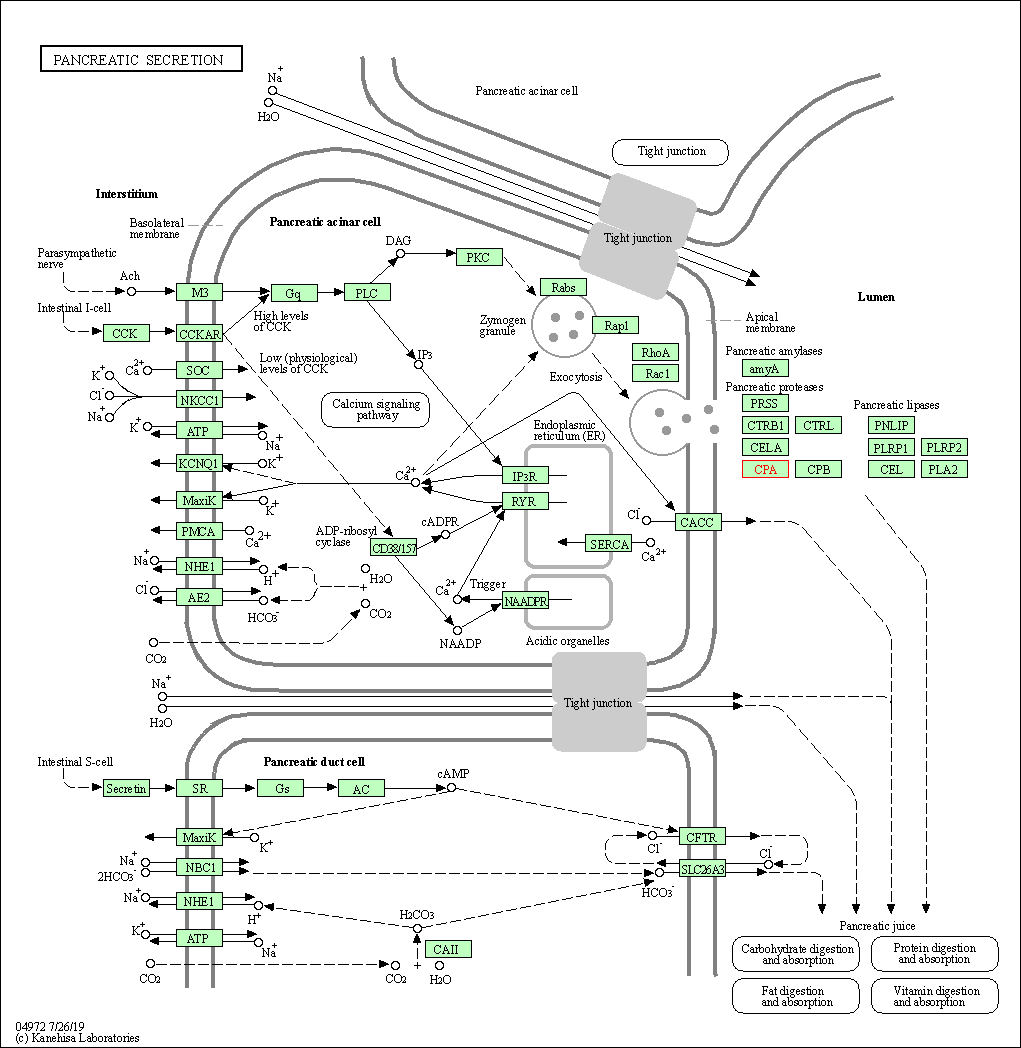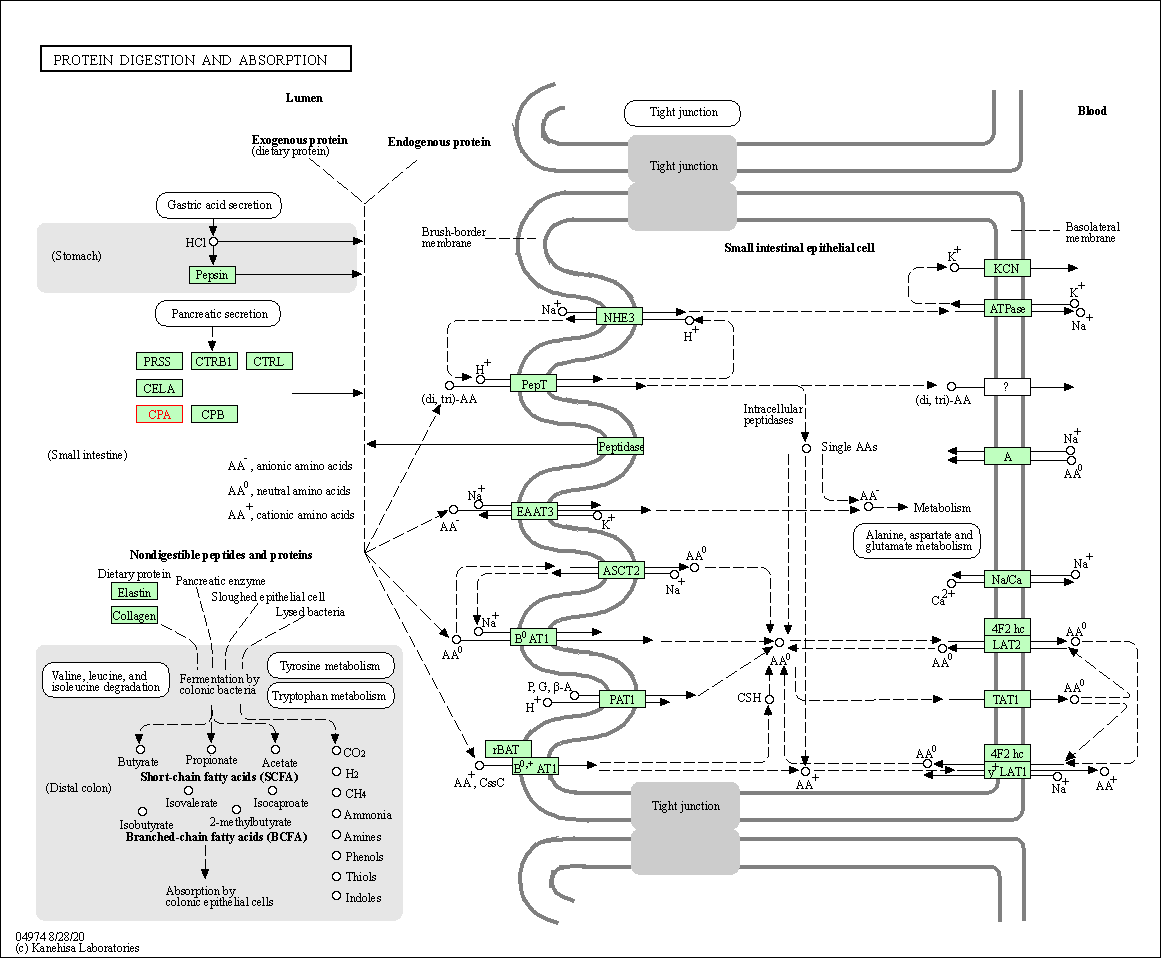Target Information
| Target General Information | Top | |||||
|---|---|---|---|---|---|---|
| Target ID |
T33966
(Former ID: TTDR01204)
|
|||||
| Target Name |
Carboxypeptidase A1 (CPA1)
|
|||||
| Synonyms |
CPA
Click to Show/Hide
|
|||||
| Gene Name |
CPA1
|
|||||
| Target Type |
Literature-reported target
|
[1] | ||||
| Function |
Carboxypeptidase that catalyzes the release of a C-terminal amino acid, but has little or no action with -Asp, -Glu, -Arg, -Lys or -Pro.
Click to Show/Hide
|
|||||
| BioChemical Class |
Peptidase
|
|||||
| UniProt ID | ||||||
| EC Number |
EC 3.4.17.1
|
|||||
| Sequence |
MRGLLVLSVLLGAVFGKEDFVGHQVLRISVADEAQVQKVKELEDLEHLQLDFWRGPAHPG
SPIDVRVPFPSIQAVKIFLESHGISYETMIEDVQSLLDEEQEQMFAFRSRARSTDTFNYA TYHTLEEIYDFLDLLVAENPHLVSKIQIGNTYEGRPIYVLKFSTGGSKRPAIWIDTGIHS REWVTQASGVWFAKKITQDYGQDAAFTAILDTLDIFLEIVTNPDGFAFTHSTNRMWRKTR SHTAGSLCIGVDPNRNWDAGFGLSGASSNPCSETYHGKFANSEVEVKSIVDFVKDHGNIK AFISIHSYSQLLMYPYGYKTEPVPDQDELDQLSKAAVTALASLYGTKFNYGSIIKAIYQA SGSTIDWTYSQGIKYSFTFELRDTGRYGFLLPASQIIPTAKETWLALLTIMEHTLNHPY Click to Show/Hide
|
|||||
| 3D Structure | Click to Show 3D Structure of This Target | PDB | ||||
| Cell-based Target Expression Variations | Top | |||||
|---|---|---|---|---|---|---|
| Cell-based Target Expression Variations | ||||||
| Drug Binding Sites of Target | Top | |||||
|---|---|---|---|---|---|---|
| Ligand Name: (2R)-4-methyl-2-[(1S)-1-sulfanylethyl]pentanoic acid | Ligand Info | |||||
| Structure Description | Crystal structure of the human CARBOXYPEPTIDASE A1 in complex with a thiirane mechanism-based inhibitor | PDB:5OM9 | ||||
| Method | X-ray diffraction | Resolution | 1.80 Å | Mutation | No | [4] |
| PDB Sequence |
KEDFVGHQVL
-84 RISVADEAQV-74 QKVKELEDLE-64 HLQLDFWRGP-54 AHPGSPIDVR-44 VPFPSIQAVK -34 IFLESHGISY-24 ETMIEDVQSL-14 LDEEQEQMFR2 STDTFNYATY12 HTLEEIYDFL 22 DLLVAENPHL32 VSKIQIGNTY42 EGRPIYVLKF52 STGGSKRPAI62 WIDTGIHSRE 72 WVTQASGVWF82 AKKITQDYGQ92 DAAFTAILDT102 LDIFLEIVTN112 PDGFAFTHST 122 NRMWRKTRSH132 TAGSLCIGVD142 PNRNWDAGFG152 LSGASSNPCS162 ETYHGKFANS 172 EVEVKSIVDF182 VKDHGNIKAF192 ISIHSYSQLL202 MYPYGYKTEP212 VPDQDELDQL 222 SKAAVTALAS232 LYGTKFNYGS242 IIKAIYQASG252 STIDWTYSQG262 IKYSFTFELR 272 DTGRYGFLLP282 ASQIIPTAKE292 TWLALLTIME302 HTLNHP
|
|||||
|
|
||||||
| Ligand Name: Octane-1,3,5,7-Tetracarboxylic Acid | Ligand Info | |||||
| Structure Description | Crystal Structure of Human Carboxypeptidase A1 | PDB:2V77 | ||||
| Method | X-ray diffraction | Resolution | 1.60 Å | Mutation | No | [5] |
| PDB Sequence |
ARSTDTFNYA
10 TYHTLEEIYD20 FLDLLVAENP30 HLVSKIQIGN40 TYEGRPIYVL50 KFSTGGSKRP 60 AIWIDTGIHS70 REWVTQASGV80 WFAKKITQDY90 GQDAAFTAIL100 DTLDIFLEIV 110 TNPDGFAFTH120 STNRMWRKTR130 SHTAGSLCIG140 VDPNRNWDAG150 FGLSGASSNP 160 CSETYHGKFA170 NSEVEVKSIV180 DFVKDHGNIK190 AFISIHSYSQ200 LLMYPYGYKT 210 EPVPDQDELD220 QLSKAAVTAL230 ASLYGTKFNY240 GSIIKAIYQA250 SGSTIDWTYS 260 QGIKYSFTFE270 LRDTGRYGFL280 LPASQIIPTA290 KETWLALLTI300 MEHTLNHP |
|||||
|
|
||||||
| Click to View More Binding Site Information of This Target with Different Ligands | ||||||
| Different Human System Profiles of Target | Top |
|---|---|
|
Human Similarity Proteins
of target is determined by comparing the sequence similarity of all human proteins with the target based on BLAST. The similarity proteins for a target are defined as the proteins with E-value < 0.005 and outside the protein families of the target.
A target that has fewer human similarity proteins outside its family is commonly regarded to possess a greater capacity to avoid undesired interactions and thus increase the possibility of finding successful drugs
(Brief Bioinform, 21: 649-662, 2020).
Human Tissue Distribution
of target is determined from a proteomics study that quantified more than 12,000 genes across 32 normal human tissues. Tissue Specificity (TS) score was used to define the enrichment of target across tissues.
The distribution of targets among different tissues or organs need to be taken into consideration when assessing the target druggability, as it is generally accepted that the wider the target distribution, the greater the concern over potential adverse effects
(Nat Rev Drug Discov, 20: 64-81, 2021).
Human Pathway Affiliation
of target is determined by the life-essential pathways provided on KEGG database. The target-affiliated pathways were defined based on the following two criteria (a) the pathways of the studied target should be life-essential for both healthy individuals and patients, and (b) the studied target should occupy an upstream position in the pathways and therefore had the ability to regulate biological function.
Targets involved in a fewer pathways have greater likelihood to be successfully developed, while those associated with more human pathways increase the chance of undesirable interferences with other human processes
(Pharmacol Rev, 58: 259-279, 2006).
Biological Network Descriptors
of target is determined based on a human protein-protein interactions (PPI) network consisting of 9,309 proteins and 52,713 PPIs, which were with a high confidence score of ≥ 0.95 collected from STRING database.
The network properties of targets based on protein-protein interactions (PPIs) have been widely adopted for the assessment of target’s druggability. Proteins with high node degree tend to have a high impact on network function through multiple interactions, while proteins with high betweenness centrality are regarded to be central for communication in interaction networks and regulate the flow of signaling information
(Front Pharmacol, 9, 1245, 2018;
Curr Opin Struct Biol. 44:134-142, 2017).
Human Similarity Proteins
Human Tissue Distribution
Human Pathway Affiliation
Biological Network Descriptors
|
|
|
There is no similarity protein (E value < 0.005) for this target
|
|
Note:
If a protein has TS (tissue specficity) scores at least in one tissue >= 2.5, this protein is called tissue-enriched (including tissue-enriched-but-not-specific and tissue-specific). In the plots, the vertical lines are at thresholds 2.5 and 4.
|
| KEGG Pathway | Pathway ID | Affiliated Target | Pathway Map |
|---|---|---|---|
| Pancreatic secretion | hsa04972 | Affiliated Target |

|
| Class: Organismal Systems => Digestive system | Pathway Hierarchy | ||
| Protein digestion and absorption | hsa04974 | Affiliated Target |

|
| Class: Organismal Systems => Digestive system | Pathway Hierarchy | ||
| Degree | 4 | Degree centrality | 4.30E-04 | Betweenness centrality | 1.39E-07 |
|---|---|---|---|---|---|
| Closeness centrality | 4.30E-04 | Radiality | 9.78E-03 | Clustering coefficient | 0.00E+00 |
| Neighborhood connectivity | 1.00E+00 | Topological coefficient | . | Eccentricity | 1 |
| Download | Click to Download the Full PPI Network of This Target | ||||
| Chemical Structure based Activity Landscape of Target | Top |
|---|---|
| Drug Property Profile of Target | Top | |
|---|---|---|
| (1) Molecular Weight (mw) based Drug Clustering | (2) Octanol/Water Partition Coefficient (xlogp) based Drug Clustering | |
|
|
||
| (3) Hydrogen Bond Donor Count (hbonddonor) based Drug Clustering | (4) Hydrogen Bond Acceptor Count (hbondacc) based Drug Clustering | |
|
|
||
| (5) Rotatable Bond Count (rotbonds) based Drug Clustering | (6) Topological Polar Surface Area (polararea) based Drug Clustering | |
|
|
||
| "RO5" indicates the cutoff set by lipinski's rule of five; "D123AB" colored in GREEN denotes the no violation of any cutoff in lipinski's rule of five; "D123AB" colored in PURPLE refers to the violation of only one cutoff in lipinski's rule of five; "D123AB" colored in BLACK represents the violation of more than one cutoffs in lipinski's rule of five | ||
| Target Poor or Non Binders | Top | |||||
|---|---|---|---|---|---|---|
| Target Poor or Non Binders | ||||||
| Target-Related Models and Studies | Top | |||||
|---|---|---|---|---|---|---|
| Target Validation | ||||||
| References | Top | |||||
|---|---|---|---|---|---|---|
| REF 1 | A new type of five-membered heterocyclic inhibitors of basic metallocarboxypeptidases. Eur J Med Chem. 2009 Aug;44(8):3266-71. | |||||
| REF 2 | Thiol-based angiotensin-converting enzyme 2 inhibitors: P1 modifications for the exploration of the S1 subsite. Bioorg Med Chem Lett. 2008 Jan 15;18(2):732-7. | |||||
| REF 3 | Discovery of potent & selective inhibitors of activated thrombin-activatable fibrinolysis inhibitor for the treatment of thrombosis. J Med Chem. 2007 Nov 29;50(24):6095-103. | |||||
| REF 4 | Discovery of Mechanism-Based Inactivators for Human Pancreatic Carboxypeptidase A from a Focused Synthetic Library. ACS Med Chem Lett. 2017 Sep 22;8(10):1122-1127. | |||||
| REF 5 | Direct interaction between a human digestive protease and the mucoadhesive poly(acrylic acid). Acta Crystallogr D Biol Crystallogr. 2008 Jul;D64(Pt 7):784-91. | |||||
If You Find Any Error in Data or Bug in Web Service, Please Kindly Report It to Dr. Zhou and Dr. Zhang.

